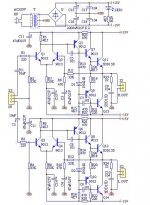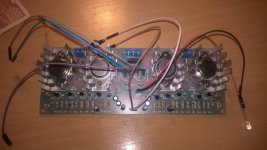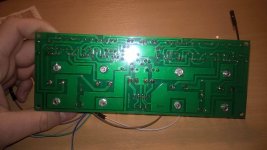Hi, this is my first post so I might miss some rules.
First of all I bought an eBay amp kit. It's an OCL 2x25W amp. It was pretty cheap (about 8$) and that's evident on how it works.
So here is the problem. When I power on everything, it buzzes trough the speaker. First I thought problem was in transformer (2x13.5V, torodial) but then I grounded zero and humming was noticeable smaller, but still present. With volume up the sound gets worse and crackling becomes stronger. So I guess the problem is in the amp circuit itself, not in transformer. While on idle, when transistor heat sink is touched humming stops, but when touch input line it buzzes even more. I got an recommendation to try with an a PC power supply, but I doubt that that would change situation. I'll put schematic in post. Thanks for any advice.
First of all I bought an eBay amp kit. It's an OCL 2x25W amp. It was pretty cheap (about 8$) and that's evident on how it works.
So here is the problem. When I power on everything, it buzzes trough the speaker. First I thought problem was in transformer (2x13.5V, torodial) but then I grounded zero and humming was noticeable smaller, but still present. With volume up the sound gets worse and crackling becomes stronger. So I guess the problem is in the amp circuit itself, not in transformer. While on idle, when transistor heat sink is touched humming stops, but when touch input line it buzzes even more. I got an recommendation to try with an a PC power supply, but I doubt that that would change situation. I'll put schematic in post. Thanks for any advice.
Attachments
Looks pretty conventional.
Try shorting the input to see if the amp buzzes that way.
If so, could be there is a bad solder joint on the board somewhere. Dual 2200 uf mains cap should be plenty, if not defective. You could use a DVM with a 10 v or 50 vac scale to see if there is ripple coming out of the mains cap. No more than 20 mv, maybe?
I'm not sure what you mean by "grounding zero" . The pin numbers of the input jack are not shown on the schematic.
If the output still hums with the input grounded, take an insulating stick like a chop stick or pen without the ink part, and poke around at the joints. A loose one could pop into the speaker.
One hand at a time, one in the pocket, 30 v from one hand to the other could stop your heart . No jewelry on hands or neck. Wear safety glasses with power on, shorting parts can explode and blow plastic everywhere.
I like grounded tip WP35 soldering irons with tin/lead rosin core solder, no fatter than 24 gauge. ***** ***** irons have not worked for me.
Try shorting the input to see if the amp buzzes that way.
If so, could be there is a bad solder joint on the board somewhere. Dual 2200 uf mains cap should be plenty, if not defective. You could use a DVM with a 10 v or 50 vac scale to see if there is ripple coming out of the mains cap. No more than 20 mv, maybe?
I'm not sure what you mean by "grounding zero" . The pin numbers of the input jack are not shown on the schematic.
If the output still hums with the input grounded, take an insulating stick like a chop stick or pen without the ink part, and poke around at the joints. A loose one could pop into the speaker.
One hand at a time, one in the pocket, 30 v from one hand to the other could stop your heart . No jewelry on hands or neck. Wear safety glasses with power on, shorting parts can explode and blow plastic everywhere.
I like grounded tip WP35 soldering irons with tin/lead rosin core solder, no fatter than 24 gauge. ***** ***** irons have not worked for me.
Last edited:
I agree about shorting of inputs....If hum is gone then you have issues with input wireing....Maybe cable you use has bad ground wire in it or its broken or you use bad potentiometer.Also put ground on heatsinks (make sure that transistors are not electricaly connected to heatsinks before you do grounding)....Colector of each transistor should not be shorted directly to heatsink but through insulation.That way you will block all interferences that are comming from heatsinks.
I doubt it is the transformer to blame and I doubt it is the amplifier to blame.
It is almost certainly down to the way you have wired up the system.
You have to sort the wiring.
First
notice that you have GND spread all around the schematic. (I see 12 GND labels on the two channels).
You have to relabel these to their correct purpose.
The Input has a Signal Flow and Signal Return. The Signal Return is labelled GND. That is wrong.
The transformer shows the centre tap as GND. That is also wrong.
These mistakes are repeated all over.
You have to connect the correct nodes to their respective terminations.
They do not all get connected together.
The shorted input test is your next stage.
Measure output offset and output noise.
Repost your sch with the correct labels and show your wiring connections.
Report your two test results for your first channel build.
It is almost certainly down to the way you have wired up the system.
You have to sort the wiring.
First
notice that you have GND spread all around the schematic. (I see 12 GND labels on the two channels).
You have to relabel these to their correct purpose.
The Input has a Signal Flow and Signal Return. The Signal Return is labelled GND. That is wrong.
The transformer shows the centre tap as GND. That is also wrong.
These mistakes are repeated all over.
You have to connect the correct nodes to their respective terminations.
They do not all get connected together.
The shorted input test is your next stage.
Measure output offset and output noise.
Repost your sch with the correct labels and show your wiring connections.
Report your two test results for your first channel build.
Last edited:
The schematic is not creative 21's. It is the one supplied by the seller and there is no point in criticizing the drafting used for promotional or illustrative purposes there. If anyone should re-draw the schematic correctly, it should be those trying to help someone who probably doesn't yet have the understanding or tools to do it.
Look here: High Power 25W 2 OCL Two Channel Amplifier Board Module Electronic DIY Kits | eBay
BTW, 4 TO3 devices with heatsinks for perhaps $2 means substandard, unsuitable or useless parts in any language. The crackling could just as easily mean bad semis and will not be related to grounding.
http://www.icpdf.com/ISC_datasheet/3DD15D_pdf_8811208/
Look here: High Power 25W 2 OCL Two Channel Amplifier Board Module Electronic DIY Kits | eBay
BTW, 4 TO3 devices with heatsinks for perhaps $2 means substandard, unsuitable or useless parts in any language. The crackling could just as easily mean bad semis and will not be related to grounding.
http://www.icpdf.com/ISC_datasheet/3DD15D_pdf_8811208/
Last edited:
Thanks for the advices, I will try and report results. As the Ian Finch says, schematic isn't mine so I'm not familiar with it. In my opinion I think transformer is good, and I reduced humming by adding more capacitors (9400uF*2). So the problem I assume is in schematic itself.
Sound quality on lower volume has got better, but still on higher volume sound is very bad. Speaker only gets low frequencies and the low ones are really hard to hear.
I'll put pictures of the PCB. Wires that are connected to place where capacitors should be, are there because I parallel connected two 4700uF capacitors and put them aside.
Sound quality on lower volume has got better, but still on higher volume sound is very bad. Speaker only gets low frequencies and the low ones are really hard to hear.
I'll put pictures of the PCB. Wires that are connected to place where capacitors should be, are there because I parallel connected two 4700uF capacitors and put them aside.
Attachments
I would be looking for bad semis/ before blaming the design. You can be sure it works acceptably even for the very little money paid but the problems will be with the parts quality (below cost and probably dumped , surplus or restamped parts) and maybe a wiring error or two, as AndrewT suggested, if you have significant hum/noise. The long leads for the caps aren't a good idea and you won't benefit from more than 4,700 uF reservoir caps anyway.
You could start by checking all the marked DC voltages and the Vbe of each transistor with a multimeter, for consistency between devices in either channel. I don't think the TO3 transistors are the best for the job and using a TO92 transistor as a driver transistor has to be dodgy but the real problem for the moment, is likely elsewhere.
Next question was raised by Mikelandgelo; what are you using for a signal source and how is it connected? Does it have a proper preamp with shielding or are parts just soldered together loose for testing?
You could start by checking all the marked DC voltages and the Vbe of each transistor with a multimeter, for consistency between devices in either channel. I don't think the TO3 transistors are the best for the job and using a TO92 transistor as a driver transistor has to be dodgy but the real problem for the moment, is likely elsewhere.
Next question was raised by Mikelandgelo; what are you using for a signal source and how is it connected? Does it have a proper preamp with shielding or are parts just soldered together loose for testing?
- Status
- This old topic is closed. If you want to reopen this topic, contact a moderator using the "Report Post" button.
- Home
- Amplifiers
- Solid State
- Need help with amp


